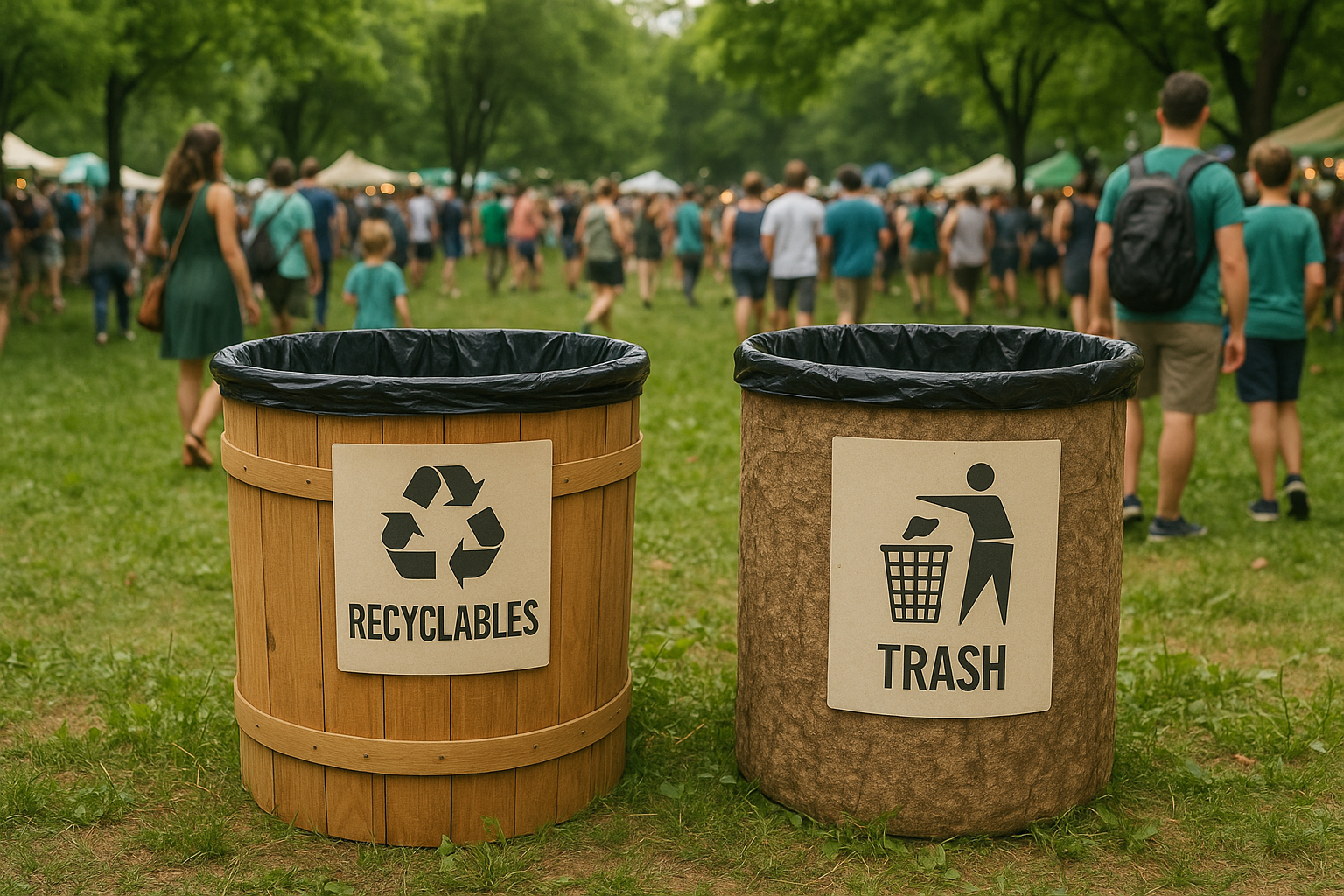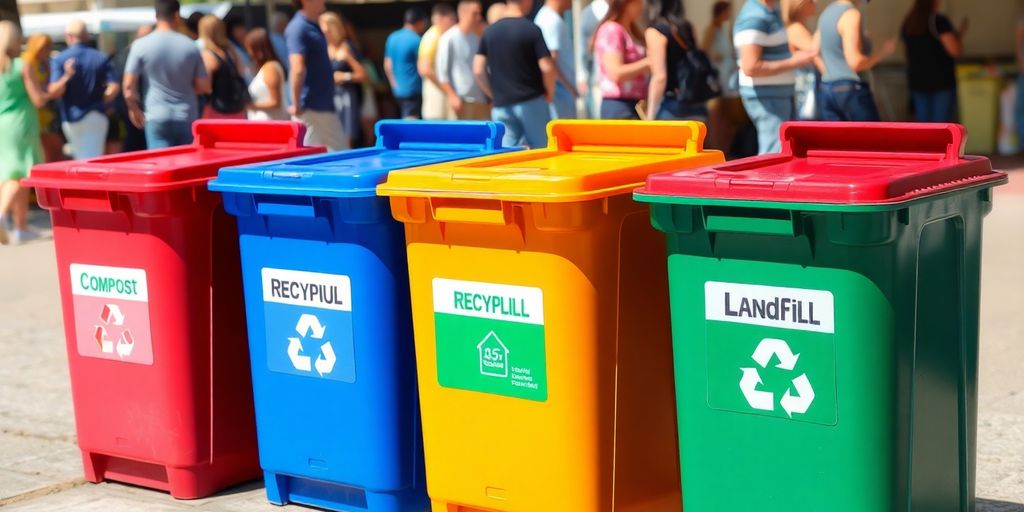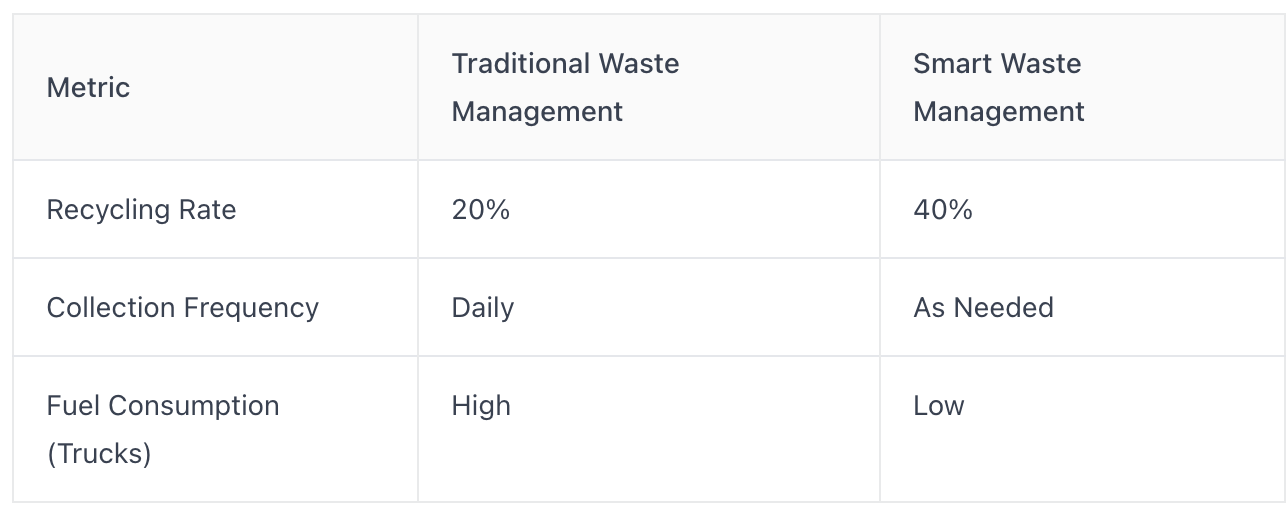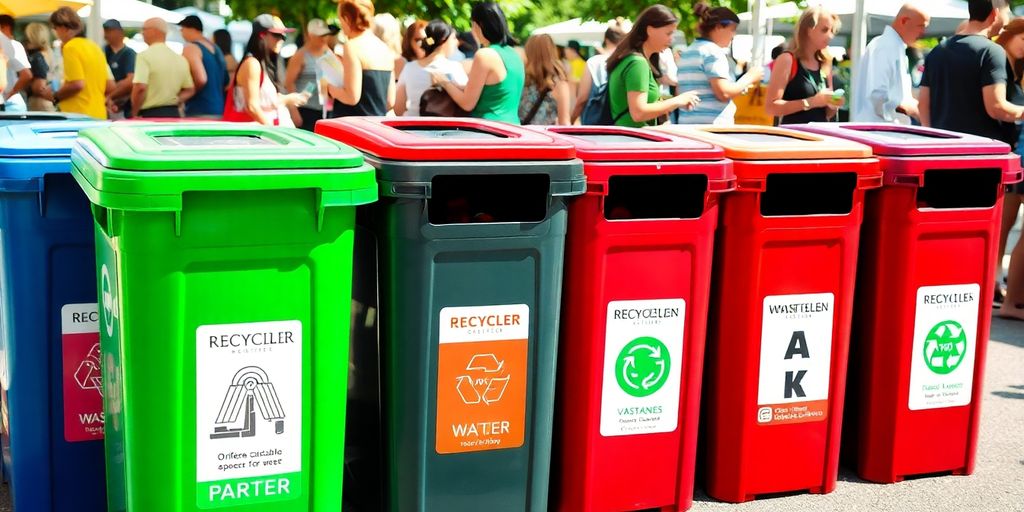Register as an organizer
Click the button below and finish your organizer registration, or fill out the form and we will be in touch to assist you.

Planning a big event can be a lot of fun, but let's be real, it often leaves behind a mountain of trash. Think about all those plastic cups, paper flyers, and leftover food. It's a lot! But what if we could make these events way greener? That's what we're talking about today: how to make events, especially big ones like festivals, produce less waste. We'll look at smart ways to handle trash, use less stuff, and even how new tech can help. This isn't just about being nice to the planet; it's about making events better for everyone involved. We're aiming for zero waste, or at least getting pretty close, by using smarter systems. This is especially true for festival waste management innovation, where new ideas are always popping up.

Waste management is evolving rapidly. It's not just about having a few bins anymore. We're seeing innovative tools and strategies that make waste reduction a key part of planning greener events. It's a real chance to make a difference by cutting down on waste and boosting resource recovery.
Setting up multi-stream waste stations is a great first step. Make sure you have separate bins for recyclables, compost, and general waste. Use big, clear signs to avoid confusion. Put these stations in places where people gather and near food areas. It's also a good idea to have staff or volunteers around to help people sort their waste correctly. Even the best system needs a little guidance.
Think beyond just throwing things away. Upcycling turns waste into something new and useful. For example, old banners can become tote bags, and wood from booths can be turned into furniture. These ideas not only reduce waste but also add value.
Eclipse.global employs innovative upcycling strategies to transform event waste into valuable resources, focusing on sustainable waste management.
Smart bins are becoming more common. These bins use sensors to monitor how full they are, so collection trucks only come when needed. This saves fuel and reduces traffic. Some systems even reward people for recycling correctly. It's all about using technology to make waste management more efficient and engaging.
Embracing smart waste management isn't just about ticking a box; it's about fundamentally rethinking how we handle resources. By integrating technology and innovative strategies, we can significantly reduce our environmental impact and create more sustainable events.
Here's a simple table showing the potential impact of smart waste management:

Here are some key benefits of using smart waste technology:
It's time to get real about making events greener. Beyond just talking the talk, there are some seriously impactful things you can do to reduce your event's footprint. It's about making smart choices that add up to a big difference.
Ditching paper is one of the easiest and most effective ways to cut down on waste. Think about it: programs, maps, speaker bios, feedback forms... all that paper ends up in the trash. Instead, use an event app. Attendees have everything they need right on their phones, and you can update information in real-time. No more last-minute printing panics!
Buying decorations and equipment for a single event? That's a recipe for waste. Renting is a much smarter option. You get what you need, use it, and then return it. No storage headaches, no disposal issues. Plus, it often works out cheaper in the long run. Consider renting things like:
Single-use plastic bottles are a huge problem. Provide refill stations with clean, filtered water and encourage attendees to bring their own reusable bottles. You can even offer branded reusable bottles as a giveaway. It's a simple change that makes a big impact. You can also find local vendors to help with this.
Food production has a significant environmental impact. Plant-based meals generally have a lower carbon footprint than those that include meat and dairy. Offering vegetarian or vegan options isn't just good for the planet; it also caters to a wider range of dietary needs and preferences. Consider these points:
Sustainable event planning isn't just about the big gestures; it's about making conscious choices at every level. From the materials you use to the food you serve, every decision has an impact. By embracing these practical practices, you can create events that are not only memorable but also responsible.
Event apps are a game-changer. Ditch the paper schedules, maps, and brochures. Instead, provide attendees with a central hub for all event information right on their smartphones. This not only reduces paper waste but also makes it easier to update information in real-time, like last-minute speaker changes or room adjustments. Plus, interactive maps and personalized schedules enhance the attendee experience. It's a win-win!
Want to know the true environmental impact of your event? Use an emissions calculator! These tools help you estimate the carbon footprint associated with various aspects of your event, from attendee travel and venue energy consumption to food sourcing and waste generation. Understanding your impact is the first step toward reducing it. Many calculators offer suggestions for offsetting emissions, such as investing in renewable energy projects or planting trees.
Planning a sustainable event involves a lot of moving parts. Project management tools can help you stay organized and on track. Use them to create checklists, assign tasks, set deadlines, and track progress. This ensures that all aspects of your sustainability plan are implemented effectively. Consider features like shared calendars, document storage, and communication channels to facilitate collaboration among your team and vendors. Good organization is key to sustainable event management.
Instead of printing out signs, posters, or informational materials, use QR codes. These codes can be scanned with a smartphone to access websites, documents, or videos. This is a simple and effective way to reduce paper waste and provide attendees with easy access to information. Place QR codes strategically throughout the event venue to guide attendees to resources, schedules, or interactive experiences.
By integrating these tools and technologies, event planners can significantly reduce their environmental impact and create more sustainable events. It's about embracing innovation and making conscious choices to minimize waste and conserve resources.

It's easy to get excited about planning a green event, but even with the best intentions, things can go wrong. Let's look at some common mistakes and how to sidestep them.
Don't just say you want to be "more sustainable." That's way too broad. Instead, set specific, measurable goals. For example, aim to reduce waste by a certain percentage or source a specific amount of food locally. Quantifiable targets make it easier to track progress and know if you're actually making a difference.
If your vendors aren't on board with your sustainability goals, you're going to have a hard time. Make sure to clearly communicate your expectations to them early on. Similarly, attendees need to know what you're doing and how they can help. Clear signage, announcements, and even small incentives can motivate everyone to participate.
It's great if you're serving plant-based meals, but what about the waste from those meals? Or the emissions from people traveling to the event? Sustainable events are about the whole picture. Balance your efforts across all areas – catering, transportation, waste management, energy use – for a real impact.
It's easy to get tunnel vision and focus on one aspect of sustainability while neglecting others. A truly sustainable event considers all the angles, from sourcing materials to disposing of waste responsibly. Think holistically to maximize your positive impact.
The world of sustainable events is changing fast. It's becoming more tech-driven, more focused on reducing waste, and more connected to local communities. Let's look at some of the key trends shaping the future of greener events.
Hybrid and virtual events are here to stay. They drastically cut down on travel, which means fewer emissions. Plus, they use fewer resources on-site. It's not just about convenience anymore; it's about making a real effort to reduce the environmental impact of events. This shift also opens up events to a wider audience, making them more accessible.
We're moving beyond just recycling. Circular design is about creating events where everything is reused, repurposed, or composted. Think about modular setups that can be reconfigured for different events, rental decor instead of buying new, and really effective recycling stations and composting systems. The goal is to create zero-waste events, where nothing ends up in a landfill.
Choosing local vendors is becoming more important. It cuts down on shipping emissions and supports local economies. Plus, it often means you're getting fresher, higher-quality products. It's a win-win for the environment and the community. People want to see events that are invested in the local area, not just parachuting in and out.
By prioritizing local vendors, event planners can significantly reduce their carbon footprint while simultaneously boosting the local economy. This approach fosters stronger community ties and promotes a more sustainable and responsible event ecosystem.
AI is starting to play a bigger role in making events more sustainable. AI can help optimize energy usage, predict waste generation, and even personalize attendee experiences to reduce waste. For example, AI can analyze attendee behavior to predict food waste and adjust catering orders accordingly. It's all about using data to make smarter, more sustainable decisions.
Here's a quick look at how AI can help:
Building a truly sustainable event doesn’t mean you have to start from scratch. There are a growing number of resources available to help you out. Let's take a look at some of them:
The Sustainable Event Alliance is a global network. It provides certifications, training, and shares best practices for those working to make events more sustainable. It's a great place to connect with others and learn what works.
ISO 20121 is the international standard for sustainable event management. It guides planners through each phase, from initial planning to the final execution. It helps you think about every aspect of your event and how to make it greener.
The Green Meetings Industry Council offers education and resources. These are specifically for planners who want to improve their green event practices. They have a lot of information on sustainable event management and how to implement it.
The EPA Sustainable Materials Management Program offers insights and tools. These help you minimize material waste and choose eco-friendly alternatives. It's a good resource for understanding how to reduce your event's environmental impact.
These resources can help event organizers streamline their planning, track their progress, and raise the bar for sustainability. They provide a framework for thinking about sustainability in a comprehensive way.
Here's a quick recap of what these resources offer:
So, what's the big takeaway here? Being sustainable isn't just a nice extra anymore; it's pretty much expected for any big event. People coming to your event aren't just looking for recycling bins and vague promises. They want to see real action. Whether it's using plates that can be composted, being smart about energy, or having a plan for leftover food, putting sustainable practices into your event shows you care. You care about the event itself, sure, but also about the planet and the community around you. Planning your next event with sustainability in mind means being thoughtful, trying new things, and teaching people. It means looking at every single part of your event—from where you get your stuff to how you talk about it and what you do after—and finding greener ways to do things that fit your goals. It also means working with vendors and places that are on board with your green vision. It's a team effort, and when everyone's on the same page, you can really make a difference.
Yes, it can. Many green choices, like going paperless with event apps or renting instead of buying equipment, can actually save money in the long run. Plus, being eco-friendly can attract more attendees and sponsors who care about the environment.
Start small! You don't have to change everything at once. Pick one or two areas to focus on first, like using digital tickets instead of paper, or setting up clear recycling bins. Once you get good at those, you can add more green practices.
Absolutely! Talk to your vendors early in the planning process. Ask them about their own green practices and if they can help you with things like reducing waste, using less energy, or providing local food options. Make sure everyone is on the same page.
The best way is to tell them why it matters. Explain how their actions, like using refillable water bottles or sorting their trash, help the planet. Make it easy for them by having clear signs and helpful staff at recycling stations.
There are many tools! Event apps help you go paperless. Carbon calculators can show you your event's environmental impact. Project management tools can keep your green checklist organized, and QR codes can replace printed materials.
It means making choices that are good for the planet, people, and your budget. This includes reducing waste, saving energy, choosing local and ethical products, and making sure your event leaves a positive mark on the community.
More blogs
Click the button below and finish your organizer registration, or fill out the form and we will be in touch to assist you.